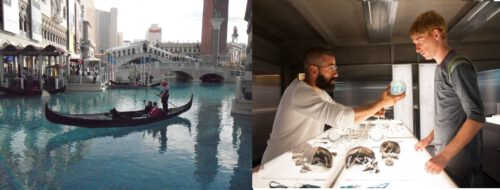
Alan N. Shapiro
media theory,
science fiction theory,
future design research



-
The “Science Fiction World” of Philip K. Dick’s Ubik
Ubik is generally regarded as Philip K. Dick’s masterpiece. In this major literary work, the struggle to occupy an “outside” relative to the “inside” of an economic-technological-virtual system is poignantly illustrated. It is a scenario where the “science fiction world” becomes everything, leaving the “safe confines” of the clearly defined literary space of the novel.
-
Brain-Computer Interface
The digital-neurological or Brain-Computer Interface (BCI) is a key SF and “real” technology of the Fourth Industrial Revolution. BCIs can be interpreted as a “becoming cyborg” of humanity. One can distinguish between mainstream versus alternative/transformative designs and implementations of the user applications to be based on BCI – the command-and-control cyborg versus the feminist-theory cyborg.
-
Fiction, Power, and Codes in Hyper-Modernism
The most significant facet for my perspective is that, in hyper-modernism, the power and control exercised via narratives and fictions in the media-technological society now get implemented on much more detailed micro-levels via algorithmic-informatic codes and digital, virtual, and cybernetic technologies.
-
Biosphere 2: The Artificial Paradise of Nature
Biosphere 2 is the enclosed artificial simulation of a natural environment in the Arizona desert. According to Baudrillard, it is the desperate project of a desperate humanity faced with its own extinction, the mania to create an artificial paradise of so-called nature and so-called reality, given that both of those nostalgic referents have already disappeared.
-
The Truman Show: “The Last Thing That I Would Ever Do is Lie to You”
Truman Burbank is under surveillance by television cameras 24 hours a day within the framework of a carefully choreographed Reality TV show watched by billions of voyeuristic viewers globally. Truman lives inside a vast Hollywood studio erected as an enclosed dome that is so large that it can be seen from outer space.
-
Wendy Chun on Software Code
In Programmed Visions: Software and Memory, Wendy Hui Kyong Chun develops her concept of “programmability” to argue that almost all social and economic institutions and procedures of life under capitalism are now shaped by software that pilots the unfolding of the future by intimately knowing data patterns and making extrapolations from the past.
-
Claus Pias on First-Order Cybernetics
The complete transactions of the Macys Conferences on Cybernetics, held between 1946 and 1953, were recently (2015) edited by Claus Pias and published in English and German. Pias discusses the importance of first-order cybernetics in the post-Second World War history of ideas in his introductory essay “The Age of Cybernetics.”
-
Bernhard Dotzler on Second-Order Cybernetics
In his major three-volume work Diskurs und Medium, Bernhard J. Dotzler considers discourse and medium as embodied knowledge or thinking, examining “archaeologically” the interconnections between technology and the history of ideas.
-
Hayles on Writing and Software Code
In Does Writing Have a Future?, Vilém Flusser lays out an intellectual project of connecting the future of software code with the history of writing. The code of the future will become more like the writing of the past – or rather, in the future there will be an as-yet-concealed hybrid of code and writing.
-
The Zeroth Law of Robotics and the Robot Unconscious
The suspenseful story of the film I, Robot depends on the energy and complexity of the zeroth law of robotics – added as an even higher ethical priority than the first three laws by Asimov in 1950 in “The Evitable Conflict.” The zeroth law then became a permanent fixture in Asimov’s science fictional literary imagination.
-
I, Robot and the Moral Dilemmas of the Three Laws of Robotics
One of the contemporary developments with which Hayles is concerned is the techno-scientific project that has attracted widespread attention of building robots which, thanks to their Artificial Intelligence, will behave and operate in imitation of humans, yet, in all probability, will not have human-like consciousness.
-
Paloque-Bergès and Sondheim on the Poetics of Code
In her book Poétique des codes sur le réseau informatique: une investigation critique, Camille Paloque-Bergès examines the history of the writing practices of software code poetry. Her ultimate emphasis is on the concept of Codeworks which was originated by the theorist, artist, and poet Alan Sondheim. Codeworks is the literary writing of informatic code.
-
Jaron Lanier’s Phenotropic Programming
In his autobiographical work Dawn of the New Everything: A Journey Through Virtual Reality, VR pioneer and founder of the company Visual Programming Languages Jaron Lanier explains his view of software code which has a lot of overlap with the view laid out in the present study.
-
Herbert A. Simon, The Sciences of the Artificial
Is computer science a science? What is at stake in the question of “the sciences of the artificial”? Herbert A. Simon was a distinguished professor for five decades at Carnegie Mellon University, one of America’s most elite and important technology institutes of higher education. Simon won the Nobel Prize in economics and the Turing Award.
-
Armin Nassehi: Complexity Not Capitalism
Armin Nassehi is a sociology professor at a prominent German university in Munich. He is one of Germany’s most well-known and successful public intellectuals. His 2019 book Muster: Theorie der Digitalen Gesellschaft received much praise in numerous book reviewsin Germany’s major newspapers and weekly news magazines.
Categories
